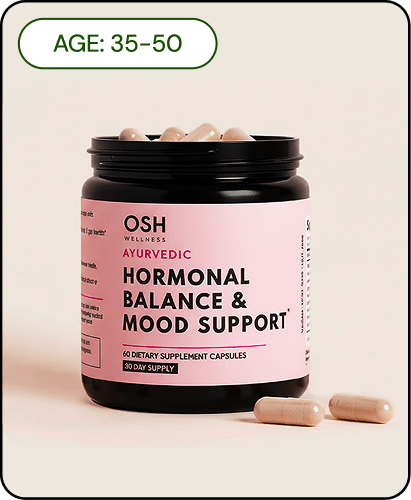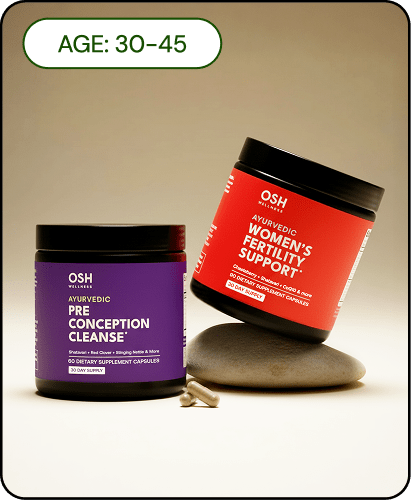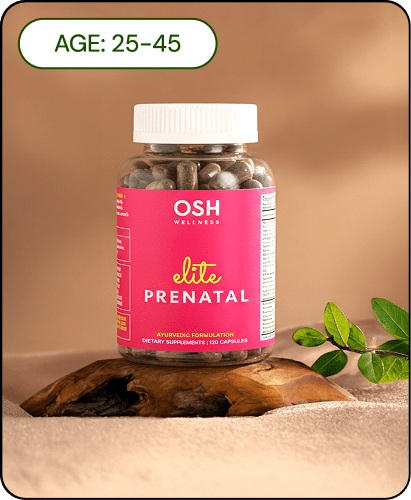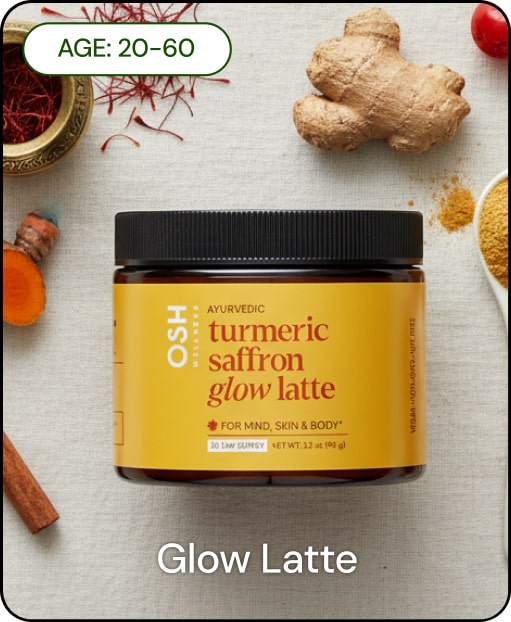Table of contents
Chasteberry, also known as Vitex agnus-castus or monk’s pepper, is a herbal supplement long used to support women’s hormonal health. For over two millennia, healers have turned to chasteberry for menstrual and reproductive issues [0]. Today, modern research is catching up to traditional wisdom. A growing number of clinical studies have investigated chasteberry’s effects on hormone-related conditions - from premenstrual syndrome (PMS) to fertility and even menopause. The results are encouraging: chasteberry appears to positively influence hormonal balance, offering natural relief for many women. In this article, we take a professional and research-oriented look at chasteberry’s hormonal balancing properties, focusing on key clinical studies that demonstrate its benefits.
We will explore how chasteberry works and delve into clinical evidence of its efficacy for PMS, cycle regularity, fertility, and menopausal symptoms. We will discover how this ancient herb can be a modern ally for women’s wellness. Let’s begin with a closer look at what chasteberry is and how it interacts with the body’s hormones.
Understanding Chasteberry and Hormonal Balance

What is Chasteberry?
Chasteberry is the fruit of the chaste tree, a medicinal plant native to the Mediterranean and Central Asia [1]. Historically, it earned the name “monk’s pepper” for its use in medieval monasteries - monks believed it helped quell libido. More importantly, traditional healers have used chasteberry for centuries to address women’s reproductive ailments. Folk medicine records chasteberry being given for irregular menstrual cycles, premenstrual complaints, and difficulties with fertility or breastfeeding. This long history of use suggested that the herb had a regulatory effect on the female hormonal system.
Modern Applications for Hormonal Issues:
In the past hundred years, chasteberry has remained prominent as a natural therapy for women’s hormonal balance [2]. It is commonly taken to alleviate PMS symptoms, such as mood swings and breast tenderness, and to help regulate menstrual cycle irregularities. Many women with conditions like premenstrual dysphoric disorder (PMDD, a severe form of PMS), polycystic ovary syndrome (PCOS), or hormone-related infertility have turned to chasteberry as a complementary approach. Healthcare practitioners in naturopathic and integrative medicine also employ chasteberry extracts for menopausal complaints (like hot flashes) and cyclical mastalgia (breast pain). The rationale for these widespread uses lies in chasteberry’s unique effects on the hormonal axis, which have been increasingly validated by scientific studies.
In the sections that follow, we’ll examine how chasteberry works on a physiological level and review key clinical research findings. The emphasis will be on peer-reviewed studies and trials that back up chasteberry’s efficacy, giving you an evidence-based perspective on this herbal remedy.
Mechanism of Action: How Chasteberry Impacts Hormones

Acts on the Brain’s Hormone Control Center:
Chasteberry’s primary mode of action is through the pituitary gland - the “master gland” in the brain that regulates other hormones. Scientific research has shown that compounds in chasteberry (particularly diterpenes) bind to dopamine D2 receptors in the pituitary [3]. By stimulating these dopamine receptors, chasteberry effectively signals the pituitary to reduce the release of prolactin, a hormone involved in PMS symptoms and fertility. Elevated prolactin can cause menstrual irregularities and breast tenderness; by keeping prolactin in check, chasteberry helps restore balance. In a 2023 endocrinology review, researchers postulated that this dopaminergic effect of chasteberry underlies many of its clinical benefits [4]. In simple terms, chasteberry “speaks” to the brain’s hormone center to recalibrate levels of key reproductive hormones.
Restoring Hormonal Balance:
The downstream effects of lowered prolactin are significant. Lower prolactin can normalize follicle-stimulating hormone (FSH) and luteinizing hormone (LH) release, thereby supporting ovulation and healthy progesterone levels in the second half of the menstrual cycle. A classic clinical trial from Germany illustrates this well: women with luteal phase defects (a shortened second half of the cycle due to latent hyperprolactinemia) took chasteberry extract daily for 3 months. The treatment significantly reduced excessive prolactin release and normalized the menstrual cycle, luteal phase length, and progesterone production [5]. In fact, deficits in progesterone during the luteal phase were eliminated only in the chasteberry group, not in the placebo group [6]. This hormonal balancing led to tangible outcomes - two women in the chasteberry-treated group even became pregnant during the trial (where none did on placebo) [7]. These findings show that chasteberry can correct subtle hormonal imbalances that affect cycle regularity and fertility.
Other Potential Actions:
Beyond the dopamine-prolactin pathway, chasteberry may exert other hormonal effects. Laboratory studies indicate that chasteberry extracts can interact with opioid receptors and even bind to estrogen receptors in cell assays [8]. These interactions suggest a complex modulation of the endocrine system, potentially influencing endorphin release and estrogenic activity. Moreover, some chasteberry components (such as flavonoids) are thought to have a mild phytoestrogenic effect, which might contribute to its usefulness in menopause [9]. While the exact mechanisms are still under investigation, the current understanding is that chasteberry helps “reset” the hormonal milieu in a gentle way. It does not supply external hormones, but rather encourages the body’s own hormone feedback loops to find equilibrium. This unique action makes chasteberry especially intriguing for conditions rooted in hormone fluctuations, notably PMS. Next, we’ll delve into how clinical studies have substantiated chasteberry’s benefits for premenstrual syndrome.
Chasteberry for Premenstrual Syndrome (PMS) and PMDD

Premenstrual Syndrome (PMS) is a collection of physical and emotional symptoms that occur in the latter half of the menstrual cycle, affecting up to 3 in 4 women to varying degrees. Premenstrual Dysphoric Disorder (PMDD) is a more severe form of PMS. Chasteberry has emerged as one of the most researched herbal remedies for easing PMS/PMDD symptoms - and with good reason. Multiple randomized controlled trials (RCTs) and reviews have found that chasteberry can significantly reduce PMS symptoms.
In fact, a comprehensive 2017 review identified 17 RCTs of chasteberry for PMS/PMDD; notably, 13 out of 14 trials in a meta-analysis reported that Vitex agnus-castus produced positive improvements in total premenstrual symptoms compared to placebo or other treatments [10]. A separate systematic review that applied stricter quality criteria still included 8 trials, and all eight showed beneficial effects of chasteberry for PMS or PMDD [11]. This consistency across studies underscores that the herb truly helps relieve premenstrual troubles.
Improvement in Multiple Symptoms:
One of chasteberry’s strengths is that it addresses both the emotional and physical symptoms of PMS. Women taking chasteberry in studies frequently report feeling less irritable and less prone to mood swings as their cycle progresses. Physical complaints like headaches, bloating, and breast tenderness also diminish. In a landmark placebo-controlled trial published in the BMJ, chasteberry extract proved significantly more effective than placebo at reducing a spectrum of PMS symptoms - from negative mood to water retention. The trial’s primary outcomes looked at changes in:
Emotional symptoms - irritability, mood swings, anger
Physical symptoms - headaches, bloating
Breast discomfort - breast fullness and tenderness
Clinical trials found that chasteberry led to marked relief in all these symptom categories when compared to placebo [12][13]. For example, the BMJ study noted a significantly greater improvement in overall PMS symptom scores in the chasteberry group, alongside pronounced benefits in each of the above domains. Women taking chasteberry reported far less irritability and breast pain than those taking a placebo.
Notable Clinical Trial Results:
To illustrate the impact, in the BMJ trial involving 170 women over three cycles, about 52% of the participants receiving chasteberry had a >50% reduction in their PMS symptom severity, compared to only 24% of those on placebo [14]. This more than doubling of the “responder rate” highlights that chasteberry can make a substantial difference for many women suffering from PMS. A 2019 meta-analysis further quantified the benefit - women using chasteberry were over 2.5 times more likely to experience a remission of PMS symptoms than women given a placebo [15]. These evidence-based outcomes are encouraging for patients and practitioners alike. They confirm that the traditional use of chasteberry for mood swings, tension, and other premenstrual woes is backed by modern science.
Chasteberry vs Conventional Treatments

Some studies have compared chasteberry to standard pharmaceutical treatments for PMS/PMDD, such as antidepressants or hormonal therapies. While antidepressants (like SSRIs) tend to have a stronger effect on severe PMDD in head-to-head trials, chasteberry still held its own reasonably well [16]. For instance, in one trial, chasteberry achieved a similar response rate to fluoxetine (Prozac) in alleviating PMDD, though another trial found fluoxetine more effective overall [17]. These comparisons suggest that for women who prefer a natural approach or cannot tolerate certain medications, chasteberry is a viable alternative. It may not completely replace an SSRI for everyone, but it offers meaningful relief without pharmaceutical side effects. Moreover, chasteberry has shown advantages for physical PMS complaints (like breast pain) where conventional drugs might not specifically help.
In summary, a robust collection of clinical evidence supports the use of chasteberry for PMS and even PMDD. The herb consistently reduces the severity of monthly mood shifts, physical discomforts, and overall premenstrual symptom scores. Women in the 30-50 age group who struggle with PMS can take heart that an herbal remedy exists with proven efficacy - one that has been validated in numerous trials and shown to be well tolerated. Next, we’ll look at how chasteberry contributes to balancing the menstrual cycle and enhancing fertility, another area of great importance to women’s health.
Chasteberry for Menstrual Cycle Regularity and Fertility

Beyond soothing monthly PMS symptoms, chasteberry’s hormone-balancing effects can translate into more regular menstrual cycles and improved fertility for some women. Hormonal imbalances, especially involving prolactin and progesterone, can lead to irregular periods, anovulatory cycles (cycles where ovulation doesn’t occur), or a shortened luteal phase (which can impede conception). By modulating these hormones, chasteberry helps restore a healthy cycle rhythm.
Regulating Irregular Cycles:
A recent large-scale study offers compelling real-world evidence of chasteberry’s impact on menstrual regularity. In 2024, a longitudinal cohort study followed 1,700 women with various menstrual disorders (including irregular bleeding, painful periods, and PMS-related breast pain) who took chasteberry extract (in the form of Cyclodynon ® or Mastodynon ® ) for three months [18].
The outcomes were striking: the proportion of women experiencing irregular menstrual cycles dropped from 9.1% before treatment to just 0.1% after three months on chasteberry [19]. In other words, virtually all women with previously erratic cycles had their cycles normalized in that short timeframe. This dramatic improvement underscores chasteberry’s power to stabilize cycle timing. The same study found that other troubling symptoms also improved in the majority of women, for example, 83% saw lighter or more controlled menstrual bleeding, and about 85% had less menstrual pain after using chasteberry [20]. These real-world results align with earlier clinical observations and give strong credence to chasteberry’s regulatory effect on the menstrual cycle.
Enhancing Luteal Phase and Fertility:
As mentioned in the Mechanism section, chasteberry can correct luteal phase defects associated with high prolactin. In the German placebo-controlled trial of women with luteal insufficiency, chasteberry not only normalized hormone levels but also led to successful pregnancies in participants who previously struggled to conceive [21]. The ability to lengthen the luteal phase and boost endogenous progesterone is crucial for fertility, as it improves the uterine lining preparation for implantation.
Chasteberry’s track record here is promising: herbal clinicians often recommend it for women trying to conceive, especially if there are signs of hormone imbalance like irregular cycles or a history of early miscarriages, potentially linked to low progesterone. Scientific literature supports this use, describing chasteberry as beneficial for conditions like latent hyperprolactinemia, mild polycystic ovary syndrome, or unexplained infertility where hormonal fine-tuning may help [22]. Indeed, an endocrinology review noted that chasteberry might be a useful and safe option for managing mild hyperprolactinemia in select cases, including women with PCOS-related hormonal disturbances, though they called for larger trials to solidify this application [23].
Real-Life Outcomes

Women who incorporate chasteberry report a variety of positive changes: more predictable cycles, reduced premenstrual breast swelling (indicating balanced prolactin), and improved cyclic mood stability. For those trying to get pregnant, having a regular ovulatory cycle greatly increases the chances of conception. While every individual is different, the clinical evidence suggests that chasteberry can gently nudge the body toward a more optimal hormonal state.
The 2024 cohort study also assessed quality of life, finding that women’s overall well-being and daily functioning improved along with their symptom relief [24]. This holistic benefit is important; it’s not just the lab numbers or cycle charts that improve, but how women feel in their day-to-day lives. By helping the body self-regulate its menstrual and reproductive hormones, chasteberry serves as a natural ally for women seeking to reclaim balance, whether their goal is cycle consistency or starting a family.
Chasteberry for Menopausal Symptom Relief

Menopause marks another major hormonal transition in a woman’s life, typically in the late 40s to 50s, and is often accompanied by symptoms such as hot flashes, night sweats, mood changes, and anxiety. While chasteberry is best known for its effects in premenopausal women, research has also explored its benefits for menopausal symptoms. The idea is that chasteberry’s subtle hormone-modulating properties might ease the hormonal rollercoaster of perimenopause and postmenopause.
Clinical Evidence in Menopause:
A double-blind RCT published in 2019 investigated chasteberry in 52 postmenopausal women experiencing troublesome symptoms (especially hot flashes and anxiety). After 8 weeks of treatment, the chasteberry group showed significantly greater improvements on the standardized Greene Menopausal Symptom scale compared to the placebo group [25]. In particular, the women taking chasteberry had lower scores for vasomotor symptoms (like hot flashes) and for anxiety [26]. By contrast, somatic symptoms (such as bodily aches) and measures of depression did not differ much from placebo, indicating that chasteberry’s strongest impact was on anxiety and heat-related symptoms.
Nonetheless, the overall “total menopausal disorder” score was significantly reduced with chasteberry [27]. The authors concluded that Vitex agnus-castus can alleviate menopausal symptoms and noted its phytoestrogenic potential as a likely mechanism.
Herbal Alternative for Midlife Wellness:
These findings are promising for women who seek non-hormonal relief during menopause. Conventional hormone replacement therapy (HRT) is effective for hot flashes but not suitable for everyone. Chasteberry offers a gentle plant-based alternative. Its apparent calming effect on anxiety is a welcome bonus, since mood fluctuations and nervousness often accompany the menopausal transition. Some older studies have also examined chasteberry in combination with other herbs (for example, with St. John’s wort) to address menopause-related mood and sleep disturbances. While more extensive research on chasteberry in menopausal women is still needed, early evidence and anecdotal reports suggest that it can be part of a natural toolkit for managing menopause. Women have reported fewer night sweats and a better sense of emotional balance when using chasteberry during the menopausal years. As a phytoestrogenic herb, it might exert a mild estrogen-like effect, which could help ease the body through the estrogen withdrawal of menopause. Importantly, any such effect is gentle and likely free of the risks associated with synthetic hormones.
In summary, although chasteberry is not a traditional menopausal herb in the way black cohosh or red clover are, it has shown the ability to reduce certain menopausal complaints, particularly hot flashes and anxiety. Its role in menopause care is still being defined by ongoing studies, but the existing clinical data indicates a positive, balancing influence even in this phase of life. For women who prefer to avoid hormone therapy, chasteberry may be worth discussing with a healthcare provider as a complementary option.
Safety and Tolerability of Chasteberry

An important aspect of any supplement, especially one used for chronic issues, is its safety profile. Chasteberry is generally regarded as a safe and well-tolerated herb for most women. Clinical trials and post-marketing surveillance have reported very few serious adverse effects. In many studies, the rate of side effects with chasteberry has been comparable to placebo.
For instance, in one placebo-controlled PMS trial, only mild side effects were observed (such as nausea or headache) in a small number of participants (4 on chasteberry vs 3 on placebo over several months). Similarly, a systematic safety review found that across numerous studies, the incidence of adverse events in chasteberry groups ranged from about 1.9% to 5%, which is quite low. Notably, no serious health risks have been linked to chasteberry in the available data. The most common minor side effects, when they do occur, include gastrointestinal upset, dry mouth, mild headaches, or skin reactions (like a mild rash or acne). These effects are usually transient and resolve on their own. In a meta-analysis on chasteberry for breast pain, researchers noted that treatment with chasteberry was “safe and associated with only mild and reversible adverse events”.
Long-Term Use and Considerations:
Chasteberry has been used in supplement form (capsules, tinctures, etc.) for decades without major safety concerns. Many women take it continuously for several months to a year or longer, depending on the condition. The trials for PMS often lasted 3-6 months, and no long-term adverse patterns emerged. However, because chasteberry works on the hormonal system, it is generally recommended to have periodic check-ins with a healthcare provider if using it long-term, to ensure it’s still appropriate for your situation.
When to Avoid Chasteberry:
One important precaution is that chasteberry is usually not advised during pregnancy. Due to its hormonal activity and the lack of studies in pregnant women, experts recommend discontinuing chasteberry once you become pregnant. It’s a precautionary principle to avoid any potential effects on the pregnancy.
Dosage and Formulations:
Typical doses used in clinical research range from about 20 mg to 40 mg of chasteberry extract per day. In Europe, common brand-name preparations (like the ones used in the studies cited) contain about 20 mg of extract per tablet, taken once daily. Tincture forms are also available; a usual dose might be 40 drops of a liquid extract each morning. Importantly, the effects of chasteberry are not immediate; they build over time. Most studies show noticeable symptom improvements after 2-3 months of consistent use. This aligns with how herbal therapies often work more gradually to rebalance systems. Patience and consistency are key when taking chasteberry for hormonal benefits.
In conclusion on safety: chasteberry is a natural product with an excellent safety record in clinical trials and traditional use. It lacks the serious side effects that can come with some pharmaceutical hormone treatments. As always, individuals should consult with their healthcare provider before starting any new supplement, especially if they have underlying health conditions or are on medications.
But overall, the evidence thus far indicates that chasteberry can be used with confidence by most women seeking its benefits, as it is well tolerated and poses minimal risk.
Relevant Products With Chasteberry
Conclusion: Embracing Chasteberry for Hormonal Balance

Chasteberry (Vitex agnus-castus) stands out as a shining example of an herbal remedy validated by scientific research. What began as an ancient tradition using chasteberry to ease women’s menstrual woes has been richly corroborated by modern clinical studies.
The evidence we’ve reviewed demonstrates that chasteberry can truly help “balance” hormones in a practical sense: it eases PMS mood swings and breast pain, regulates irregular cycles, supports fertility, and even ameliorates certain menopausal symptoms. Women in their 30s, 40s, and beyond who are looking for natural hormonal support can take encouragement from the positive results seen in trials.
For instance, multiple studies showed significant PMS relief and improved quality of life with chasteberry use, while others documented normalized hormone levels and cycle lengths that pave the way for better fertility outcomes. These aren’t just abstract numbers; they translate into real-life improvements like feeling more in control of your emotions each month, not having to dread debilitating breast tenderness, or finally achieving a regular cycle after years of unpredictability.
Professionally speaking, chasteberry offers an evidence-backed, gentle approach to hormonal harmony. It’s informative to see how a single plant can positively influence the complex endocrine orchestra in a woman’s body. Unlike drastic pharmaceutical interventions, chasteberry works gradually and in tune with the body’s own rhythms, which likely accounts for its high tolerability.
Research-oriented readers will appreciate that ongoing studies continue to refine our understanding of Vitex’s benefits, but the consensus so far is favorable: the herb is effective for a range of female hormonal concerns and carries a strong safety profile. Rather than sow doubt about its efficacy, the breadth of clinical data encourages confidence in using chasteberry as a complementary therapy.
In closing, chasteberry can be viewed as a natural balancer, a botanical ally helping to smooth the hormonal ups and downs that many women experience. Its usage is rooted in tradition, but now anchored in scientific credibility. For women seeking holistic support for PMS, menstrual regularity, or menopausal comfort, chasteberry deserves a prominent place on the list of options.
By bridging the gap between traditional wisdom and modern medicine, chasteberry exemplifies how we can embrace safe, plant-based solutions in our pursuit of health and hormonal well-being. As always, individual results may vary, but the positive outlook from clinical studies backing chasteberry’s hormonal balancing properties is a reassuring guide for those considering this herbal remedy.








